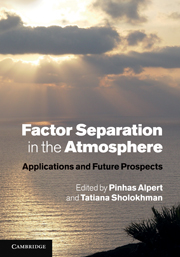Book contents
- Frontmatter
- Contents
- List of contributors
- Foreword
- Preface
- 1 Introduction
- 2 The Factor Separation Methodology and the fractional approach
- 3 Investigation of the Factor Separation features for basic mathematical functions
- 4 Factor Separation Methodology and paleoclimates
- 5 Meso-meteorology: Factor Separation examples in atmospheric meso-scale motions
- 6 Using the Alpert–Stein Factor Separation Methodology for land-use land-cover change impacts on weather and climate process with the Regional Atmospheric Modeling System
- 7 Application of Factor Separation to heavy rainfall and cyclogenesis: Mediterranean examples
- 8 Experience in applying the Alpert–Stein Factor Separation Methodology to assessing urban land-use and aerosol impacts on precipitation
- 9 Free and forced thermocline oscillations in Lake Tanganyika
- 10 Application of the Factor Separation Methodology to quantify the effect of waste heat, vapor and pollution on cumulus convection
- 11 The use of the Alpert–Stein Factor Separation Methodology for climate variable interaction studies in hydrological land surface models and crop yield models
- 12 Linear model for the sea breeze
- 13 Experience and conclusions from the Alpert–Stein Factor Separation Methodology
- 14 Tagging systematic errors arising from different components of dynamics and physics in forecast models
- 15 Some difficulties and prospects
- 16 Summary
- Appendix: References employing the Alpert–Stein Factor Separation Methodology
- References
- Index
6 - Using the Alpert–Stein Factor Separation Methodology for land-use land-cover change impacts on weather and climate process with the Regional Atmospheric Modeling System
Published online by Cambridge University Press: 03 May 2011
- Frontmatter
- Contents
- List of contributors
- Foreword
- Preface
- 1 Introduction
- 2 The Factor Separation Methodology and the fractional approach
- 3 Investigation of the Factor Separation features for basic mathematical functions
- 4 Factor Separation Methodology and paleoclimates
- 5 Meso-meteorology: Factor Separation examples in atmospheric meso-scale motions
- 6 Using the Alpert–Stein Factor Separation Methodology for land-use land-cover change impacts on weather and climate process with the Regional Atmospheric Modeling System
- 7 Application of Factor Separation to heavy rainfall and cyclogenesis: Mediterranean examples
- 8 Experience in applying the Alpert–Stein Factor Separation Methodology to assessing urban land-use and aerosol impacts on precipitation
- 9 Free and forced thermocline oscillations in Lake Tanganyika
- 10 Application of the Factor Separation Methodology to quantify the effect of waste heat, vapor and pollution on cumulus convection
- 11 The use of the Alpert–Stein Factor Separation Methodology for climate variable interaction studies in hydrological land surface models and crop yield models
- 12 Linear model for the sea breeze
- 13 Experience and conclusions from the Alpert–Stein Factor Separation Methodology
- 14 Tagging systematic errors arising from different components of dynamics and physics in forecast models
- 15 Some difficulties and prospects
- 16 Summary
- Appendix: References employing the Alpert–Stein Factor Separation Methodology
- References
- Index
Summary
The Alpert–Stein Factor Separation Methodology (FS) has been applied effectively in the Regional Atmospheric Modeling System (RAMS) to assess the relative contribution of different factors to weather and climate processes. In this chapter we will discuss model sensitivities to historical and future changes in land-use land-cover (LULC), biophysical and radiative effects of increased carbon dioxide (CO2) concentration and land-cover representation assessed using FS in weather and regional climate simulations for various regions around the world. This method emphasizes the importance of land-cover changes and CO2 biological effects when addressing regional-scale future climate change impacts.
Introduction
Observations and modeling studies show that land-surface properties can influence the near-surface atmosphere through exchanges of heat, moisture, momentum, gases, and aerosols on timescales ranging from seconds to years, and on local to regional and possibly global spatial scales (Pielke, 2001; Arora, 2002; Pielke et al., 2002; Pitman, 2003; Niyogi et al. 2004; Foley et al., 2005). Urbanization, deforestation–reforestation, conversion of natural areas to agriculture, and increases in irrigation areas are some LULC modifications that often affect albedo, leaf area, roughness length, and root biomass. These landscape modifications can lead to changes in near-surface fluxes that affect temperature (e.g., Baidya Roy et al., 2003; Strack et al., 2008), humidity (e.g., Douglas et al., 2006, 2009; Roy et al., 2007), boundary-layer process, and precipitation (Pielke et al., 2007a). These changes can potentially feed back to the biophysical variables through a two-way interaction, enhancing or decreasing the initial perturbation (Pitman, 2003; Pielke and Niyogi, 2008).
Information
- Type
- Chapter
- Information
- Factor Separation in the AtmosphereApplications and Future Prospects, pp. 67 - 86Publisher: Cambridge University PressPrint publication year: 2011
